Andy Quitmeyer’s wonderfully weird world of Digital Naturalism
Published 30 June 2019 by Cherise Fong
Ahead of the 2nd Digital Naturalism Conference in Gamboa, Panama in August 2019, Makery spoke with instigator Andy Quitmeyer about the origins of Dinacon, Dinalab and the whole DiNa movement.
For those who don’t know Andy, his titles may sound intimidating: the Digital Naturalism Conference (a.k.a Dinacon) is actually a spoof on the stuffy posturing academic conference—a hands-on, outdoor summer camp that gathers anyone who’s into art-tech-science-nature to connect, create and collaborate in the jungle; the Digital Naturalism Laboratories (a.k.a Dinalab) is actually his newly acquired two-story house in Gamboa, Panama that he and his partner are progressively renovating into an open media lab, makerspace and art-tech residency.
Dr. Andrew Quitmeyer, PhD—no less a digital media expert, industrial engineer, documentary filmmaker, award-winning designer and ex-professor at the National University of Singapore—is a true adventurer who explores interactions between wild animals and computational devices, who has led multidisciplinary activities, workshops and Hiking Hacks to bring DIY electronics into raw nature in the U.S., Panama, Philippines, Madagascar, China, Cambodia, Thailand, Turkey, Ecuador, Galapagos and beyond, whose research inspired the television series Hacking the Wild… as well as a friendly, down-to-earth guy with a clear vision for our harmonious and sustainable future, interacting with non-human creatures, in the forest.
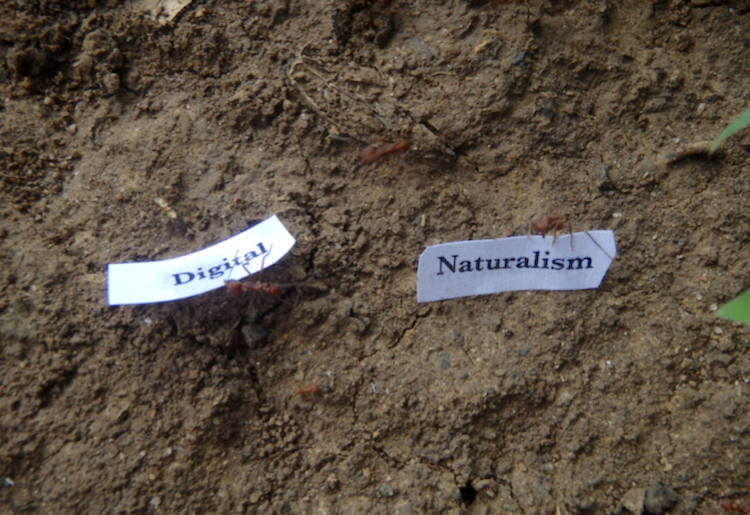
What was the original spark for Digital Naturalism?
It all started when I was working in a robotics lab that was paired up with a biology lab. And they were studying ants. They would get a grant to hire this robotics lab to help do computer vision for their ants and stuff like that. I was working on the robotics side, and I just felt kind of disappointed—there’s all this pressure for interdisciplinary and collaborations, but cynically, it seems like mostly what happens is people just go through and check the boxes. We would only meet up like once a year and then we would all just kind of work in our own compartments. Also somewhat cynically, it seemed like there wasn’t much funding available for doing just basic science. This was my first encounter with this, and the more I worked there, the more I really understood the limits of what our technology was capable of in this type of collaboration.
The other low-hanging fruit was that we could actually be helping these field biologists out. There are a lot of challenges that the field biologists have, but what is sexy and what gets funded are things that are much more difficult or basically impossible to do—versus the things they might actually need right now on the ground that could change their whole field work and save them months of time doing basic tasks. We weren’t helping them with that, instead we were doing these big moonshot kind of things.
So the beginning of this Digital Naturalism stuff was: How can digital interactive technology support field biologists’ values of working in the field, being with their animals, interacting with them and studying their behaviors in natural environments? Instead of “What technology can we shove out there?” looking at “What are the values of field biology and how can tech support that?”
Andy Quitmeyer explains his concept of “Digital Naturalism” (2016):
It’s also an exercise in design and co-evolving a new medium that we have, along with the oldest medium that we have. What really fascinates me is that, of all the things that we have in the universe, there are only two things that can do behaviors: creatures and computers. Nothing else can actually take an input, process it somehow, respond to that input and create new stimuli in that environment. So I see this really lovely interplay that can happen if we put different living creatures and connect these senses and actions they can do with the senses and actions of digital things that we create to make these dynamic sorts of interactions.
That will help us understand more about the design of living creatures as well as how to design our computers to be more robust, more interesting, more fascinating, and really pushing the bounds of what our digital behaviors can be like—other than this version where there are more digital slaves, where we command absolutely what they want to do. In some way, I want to free the computers to make them a little more wild themselves.
A good way to do that is to stop exclusively designing for human-centric things—starting with just the basics of designing something that works with some non-human creature’s concepts of time, space, interactions with the physical world and communicating with them in some other spectrum or way that we’re not used to. It really changes your idea of design of what these things can be built to do and how they can interact and play with the world.
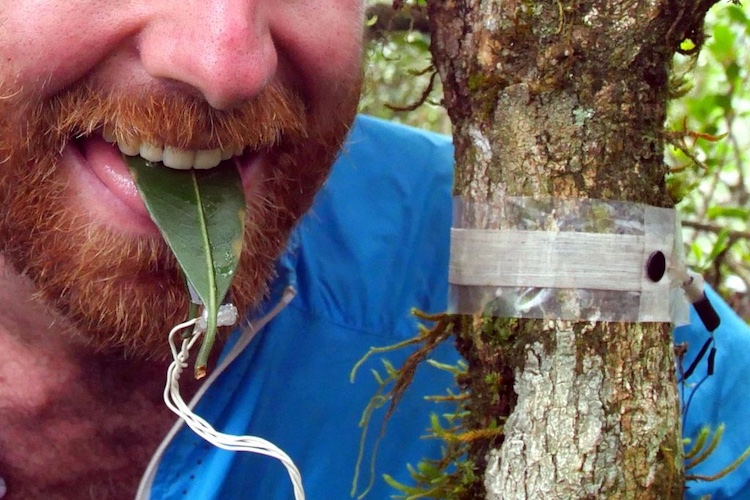
So what happens when you bring the tech lab into the jungle?
The thing we notice most when doing these outdoor labs is, and this even applies to people with even more field experience, that you’re constantly reminded about how much your brain’s models of, like, the size of this ant, or the angle of this tree, or just the way that the forest works, is way different than the actuality of it. So one of the things that we see with people who haven’t had as much field experience is they’ll often come in with a whole bunch of ideas and they’ll get all prepared and be set on this one specific idea: “This is the idea, I’m gonna go into the forest, I’m gonna deploy it, it’s gonna be great.” And over and over again, the most common thing on every single Hiking Hack, myself included, is just in those first 5 seconds when you pull out the thing, that you’ve been thinking about for months, and you’re like: “Oh wait a second, this might not work…”
On the very first Hiking Hack, we had a little laboratory on some trees, like, over there. Then over here, was a creek where we were trying to test something with the ants between a couple of trees. Even in the gap of going between our little lab bench over here to between these trees just a couple feet away, you would be thinking, “I’m gonna fill this thing and it’s gonna fit between these trees,” then you go over there and you’re like, “Oh wait, in my mind it’s just two perpendicular trees and then it goes across, but actually one has this weird root, so now I have to carve this and fit it in better…” So it was interesting to see how even over a short distance, your brain simplifies everything that you’re looking at when you’re thinking about all these other aspects of it.
It’s super useful to have that feedback from the environment. The whole reason that we started doing the Hiking Hacks was that we would be in a laboratory in Gamboa, Panama, and the forest would be a couple kilometers from where we were doing our research. So many times, we were building a new ant agitation device, then we’d drive all the way out there and realize, “Oh wait, this doesn’t fit on the tree, or these sensors are in the wrong place to look at the ants,” and then we’d drive back. So more and more we were like, screw this, let’s just bring the whole lab out there!

How did your experiences at other camps inspire the Hiking Hacks and the Digital Naturalism Conference?
Signal Fire is the closest I came to doing my first proto Hiking Hack in Panama in summer 2014. I was in-between field seasons, chatting with friends: “All this lab work we’re doing, let’s try to do it on an expedition while we’re moving around, and see if it can be done.” Then I heard about Signal Fire, where they were doing art out in the wild during their backpacking trips. I thought that was super cool, so I joined up for a 9-day trip in April 2014. I was really just testing how much stuff I could carry, does it make sense to actually do soldering out in the wild, all these questions I had no idea about.
Signal Fire was also super cool in that they build in social discussions and different kinds of activism concepts along with the nature that you’re roaming around and exploring, along with the creation of different kinds of art projects and things that you’re doing with yourself out there. So that was very inspiring, trying to expand the scope or just not limit the scope, have all these tentacles of technology and the environment and human social relations always permeating each other, because we can’t just ignore them.
The next big influence was going to PIFcamp. It was Marc Dusseiller [the man behind Hackteria] who connected me with Marko Peljhan [the man behind Makrolab], and they invited me to do some workshops up there in 2017. That was what really helped me make the bridge from Hiking Hacks, which were more one-off singular events with a small group of 10-12 people. I saw how PIFcamp could put on a very loosely organized thing that was still super successful and super productive with people from many different backgrounds working with each other between the interesting natural environment and the cool tech stuff they brought. Also just having a great time. Things like at the end of PIFcamp, they would have this open day where people from the community could come in and check out all the weird different stuff that people had been working on. PIFcamp also had a dedicated documentation team, so I got to see people going around saying “Hey, we see you’re doing a project, we’ll help you collect footage about it.” It was helpful to see fully in action.
“Creatures” at PIFcamp 2017:
So at the end of PIFcamp, I just declared that we were going to have Dinacon somewhere in the world in the next year. That everyone at PIFcamp was invited, and it was going to be free. This was even before we had decided where it was going to be, anything like that. I was just so blown away by PIFcamp: If they can do this, we can do this! Then when I came back to Singapore right after that in August 2017, I met up with [Dinacon co-organizer] Tasneem Khan.
But the Digital Naturalism Conference also came from this real frustration with the way that conferences work in academia, where the whole point is supposed to be to get people together in a unique place and have them exchange ideas. Instead, everybody hurriedly spends lots of money on hotels to be next to each other, while you check off the requirements for being able to add an extra line to your CV, so when you go up for tenure you can say, “Yes, I had 6 and 6 is more than 3, so I’m doing good,” or something like that. That was one of the reasons we put on Dinacon: I can use my savings from 10% of my salary for one year’s work, which is the cost of not going to two academic conferences, rent out this whole facility and get a lot of people there for two months to have all kinds of amazing conversations and build stuff and do things.
“Dinacon: Week One” (Koh Lon, Thailand, 2018):
Trailer for Dinacon2 (Gamboa, Panama, 2019):
How did you decide to finally quit your job as a professor and set up your own permanent Digital Naturalism Laboratories in Panama?
When I was doing my PhD, sometimes people would have ideas about what they want to do and they come gradually, like “I figured out this piece, then I figured out this piece, then that piece…” But then sometimes I’ll have ideas and it just all comes at once, like boom, fully formed, Athena out of Zeus’s head: This is what should happen, this is what should be on Earth. The Digital Naturalism stuff came to me that way.
Originally I thought I was going to be able to expand my PhD thesis and do my research as an academic with my fancy professor job, doing design and art and field biology and behavioral ecology kind of stuff all at once. But the more I interacted with academia, the more I got incredibly jaded, especially seeing it from a professor point of view: how much energy was directed toward completely pointless endeavors that were often pulling energy away from doing things that can actually help people, help the environment or even just learn about stuff.
So doing Dinacon was great, but it opened my eyes even more to screw this, let’s just start our own whole research facility. Just by ourselves. So me and my partner Kitty, we pooled our money. She was being incredibly supportive, because she was being a freelance artist in Singapore having a great time there, but she could tell how much it was just killing me working at this job. It had always been my “master plan” that when I’m 50 then I’ll quit everything and then maybe I’ll have my own field station then I’ll go gung ho and do this. She said, screw that, just do this now. Which was awesome. I’m super grateful that she pushed me to make this decision too. She could see how driven I was toward this thing. If we can try to pull it off now, she thought it was worth it and I did too, even though it’s absolutely terrifying.
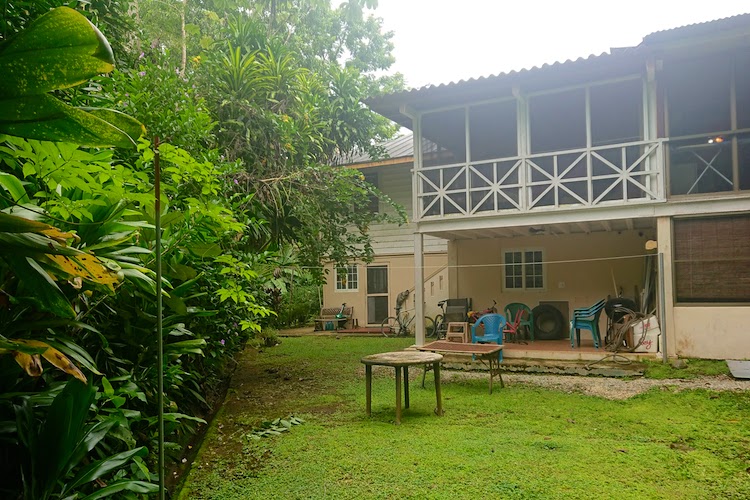
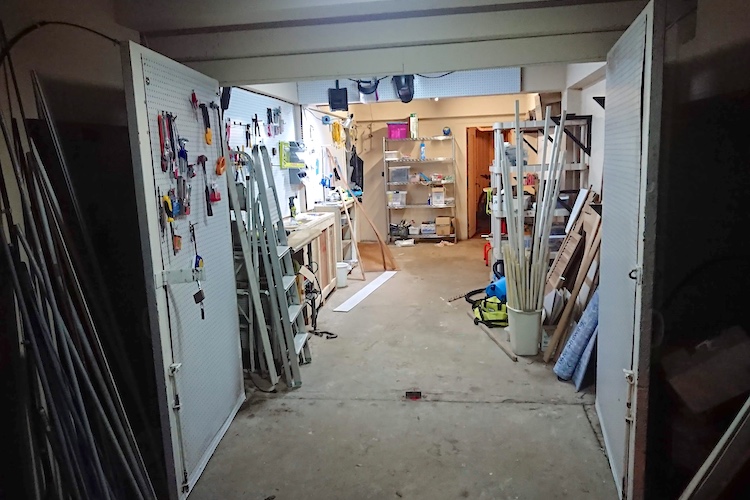
Why in Gamboa?
When we decided to leave, we were trying to look around at different places, weighing the pros and cons, there were a lot of different factors we were thinking about. We wanted something that was going to be right next to and preferably embedded in an interesting natural environment that we could do research with. We wanted something that we could afford, a place that also had decent international accessibility, so that if we had events like Dinacon, people could actually make their way down here. We were looking at quite a few different places, talking to people in Indonesia, Canada, also looking at visa requirements.
The thing that really won out for us was that we didn’t have that many resources of our own, so by moving to Gamboa, where the Smithsonian Tropical Research Institute (STRI) has their institute plugged into the nature and all the weird cool stuff around here as well as the communities, we could piggyback off of that. That was the key deciding factor for us. There’s a vibrant community already in place here that we already have a good amount of connections with and that we could plug into. Also not a lot of industrial tools and centers available, so a niche that we could fill in that doesn’t really exist here yet. So far it’s going pretty good.
In terms of the actual scientific community, I’ve been decently plugged in. My relationship with STRI has been a bit of a continuation of my PhD, where I’m still bouncing around and trying to help people out, but more of a powered-up version. Now instead of just telling someone about this thing, I can say, come back to my lab, we’re gonna build it right now. That’s been really satisfying.
“Cecropia-Azteca Symbiosis” by Andy Quitmeyer and Peter Marting (2012):
So what’s next in Digital Naturalism?
This is the whole big plan: Step 1 is to get fancy, so that fancy people take your weird ass shit seriously. So for me the getting fancy was getting a PhD. Step 2 is to channel stuff into infrastructure for doing it, get it set up. Phase 3 is to have it really thriving. So my goal with Dinalab here is that it begins taking on a life of its own. We’ve already started having some artist residencies and tech residencies here, but having that become more of an established thing, where other people who were kind of like me working in these different areas of art tech or design can be lured down here and driven insane in wonderful ways by all the amazing wildlife and creatures and strange interactions that people are learning about them right in their backyard. So part of that is luring people down here to infect them with cool jungle love.
Next is having this place being able to maybe drum up enough consulting work and design work with scientists that we can actually hire people full-time, so that we can have paid positions where people could come down here and work for a year developing three-dimensional mazes that bats can fly through, that we can sense and install right in the jungle. Ideally that happens in five years, we’ll see.
But then, the Digital Naturalism infection keeps spreading! Then I would love to be able to have this place as a model of a pure blend of art-science-design existing harmoniously and sustainably in and surrounded by a cool natural area, so that then we can start explaining this model to other places around. So ideally, within 10 years’ time, I would love to have three other Dinalabs around that we can also try to help run, and develop these amazing cool communities of interesting naturalists who wander around and become curious and develop tools to spark their own curiosity when they’re out in the forest, and also tools to start answering some of the questions of their curiosity.
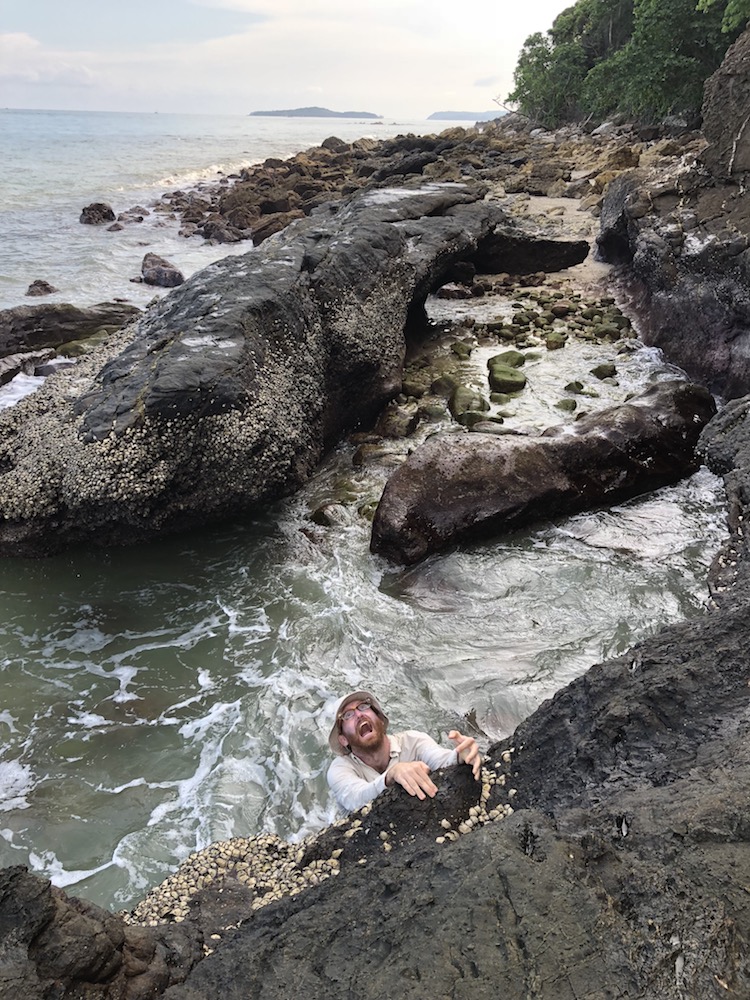
So that’s the eventual endgame of this. Some people are like: Is this tech for field biologists? Or making art from field biology stuff? Really the endgame is dissolving any of these distinctions and just a) making people love the non-human stuff going on around them, and b) having them have the agency to craft whatever tools, to program whatever things they have, to help encourage this curiosity and empathy and interactions with things that exist around them.
Honestly, I don’t even care as much about this certain view of science as this progressive march toward more facts; I don’t really care that much about how much data we can accumulate from this thing. Instead I want people to accumulate interactions with things that aren’t human. I want them to build relationships with the non-human environment that surrounds them. That’s the true endgame there. Then let’s say in 20 years, everyone is a weird cyber jungle punk wandering around in a wonderful utopian paradise… and all of our forests still exist!
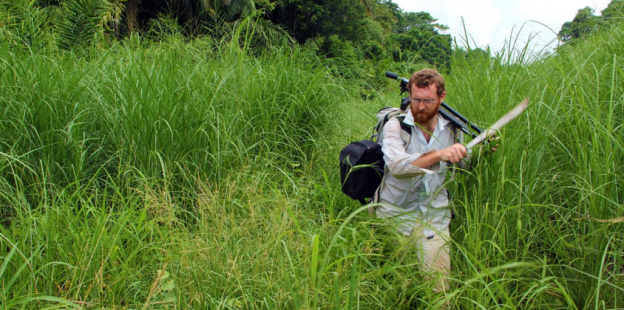
More on Digital Naturalism, Dinacon and Dinalab
Read our report from the 1st Dinacon in 2018: The Thai island and the biopirates
